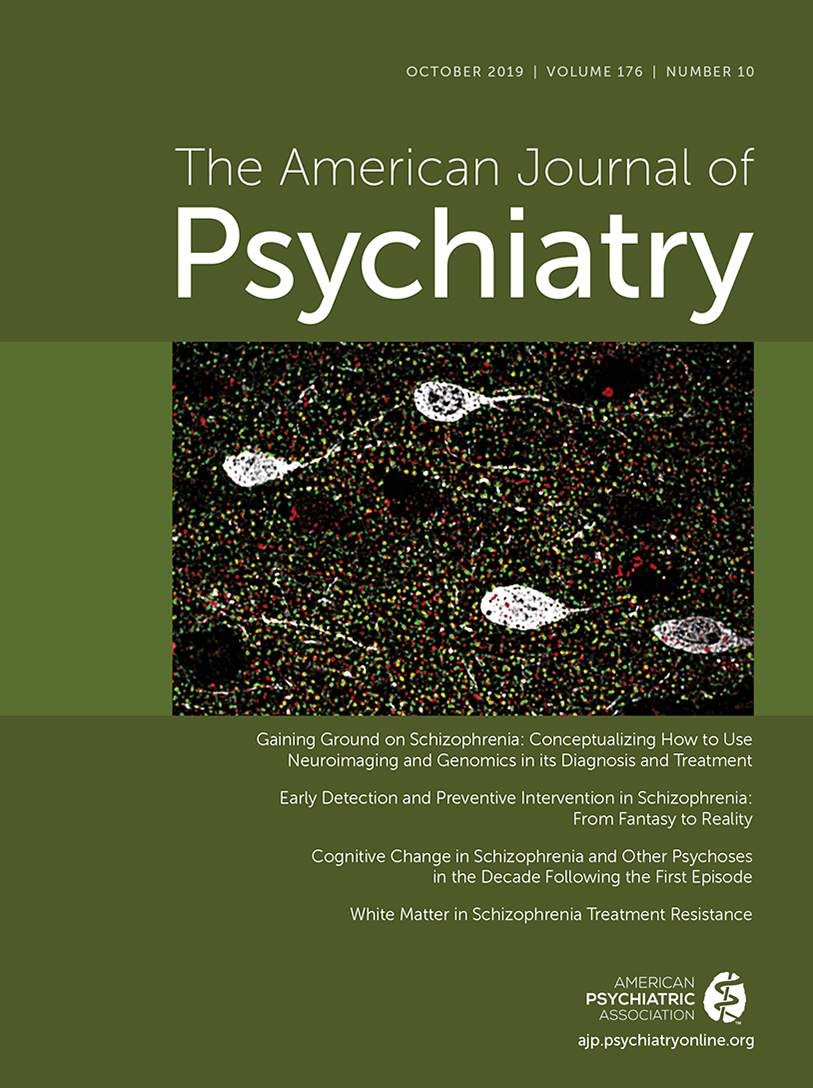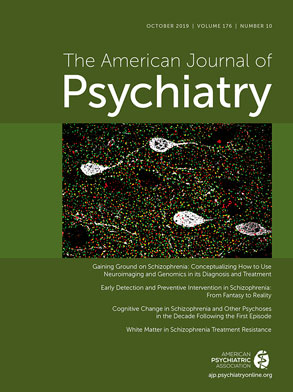Identification of youths early in the psychosis process presents a challenge but also an opportunity to relate brain-based measures to course of illness. The heterogeneity in disease progression is substantial, and identifying potential biomarkers can elucidate mechanisms and thus guide targeted interventions as envisioned by precision medicine (
1). Neuroimaging-based parameters have been increasingly applied to investigate the relation between treatment variables and neuroanatomic measures such as brain volume, cortical thickness, gray matter density, white matter integrity and connectivity and, to a more limited extent, functional measures such as resting-state connectivity and cerebral perfusion. Conspicuously limited are studies that use functional MRI (fMRI) to examine regional activation in response to task demands (
2). This relative absence is notable given that failure to recruit the underlying circuitry when performing a task is likely the proximate cause for cognitive deficits, as activated fMRI parameters provide better predictors of performance than resting-state measures (
3) and therefore may relate to outcome. Indeed, as Smucny and colleagues (
4) point out in this issue of the
Journal, there are only a handful of fMRI studies with small samples that have attempted to link abnormalities in activation to intervention outcomes.
The article by Smucny and colleagues (
4) builds on extensive experience implementing a cognitive control continuous performance task in the study of psychotic disorders. Smucny et al. probed the underlying circuitry in a subsample of research participants who were included in subsequent early psychosis specialty care. The authors report that only the fMRI-based measure of cognitive control obtained at baseline had a 70% predictive value of defined improvement status on the Brief Psychiatric Rating Scale a year later. The article attests to the extensive attention and deliberations the authors had to undertake to integrate their rigorous experimental approach with “real world” care early in the course of psychosis. Ascertainment bias, image processing across scanners (1.5-T and 3.0-T scanners), and analytic approaches must be considered and are well detailed in the article. The authors recognize the study limitations, including a relatively small sample, the naturalistic design, and the sparse data on potential factors that can contribute to outcome. Other measures that could be related to clinical presentation and course include genetic vulnerability, comorbidity, environmental or socioeconomic deprivation, stressful life events, and family setting (
5,
6). Furthermore, the study examined a single region and a single task. There are methods to administer more extensive neurocognitive testing in the scanner that identify domain-specific patterns of activation (
7). In all likelihood, heterogeneity of psychosis relates to variations in specific or distributed brain systems that differentially associate with course and outcome. Therefore, while the study offers a unique contribution toward identifying potential biomarkers of early progression of psychosis, as the authors recognize, theirs is a first step on a long road.
Perhaps as remarkable as the accomplishment of this study is the paucity of treatment studies in which biomarkers related to brain circuitry activation are obtained along with equally rigorous clinical data. It is concerning that only a handful of studies have related brain circuitry activation parameters to illness measures of improvement early in the course of psychosis. What may account for the scarcity of informative research on acute and longer-term relation of brain-behavior activation measures to clinical parameters, such as symptom improvement and functional outcome?
This dearth of studies on task-activated fMRI may relate to the complexity of administering well-controlled tasks in a scanner, challenges in standardizing tasks and settings across sites, the relatively low signal-to-noise ratio, the requirement for active participant engagement, and the high computational demands. It is difficult to set up standardized activation paradigms across sites and studies. Neuroanatomic and resting-state connectivity studies do not require cooperation of research participants beyond their agreement to spend time in the scanner without excessive head motion. In contrast, task-related fMRI studies require equipping the scanner with input and output devices and ensuring that the participants understand the task and are awake and fully engaged in its performance. Furthermore, the low signal-to-noise ratio of the blood-oxygen-level-dependent contrast necessitates more extensive image processing and control for potential artifacts that may confound interpretation (
8).
Another obstacle for large-scale implementation of complex neuroimaging paradigms in the context of intervention studies may lurk in the chasm between basic translational research and intervention research, which seems particularly wide in psychiatry. The level of sophistication of clinical trials has improved with standardized intervention procedures assessed with rigorous designs and validated measures of symptoms and outcomes (
9). At the same time, basic and clinical neurosciences have advanced substantially in relating behavioral domains to brain systems and identifying abnormalities in psychiatric populations that relate to symptom severity. In all likelihood, the heterogeneity of psychotic disorders can be partly accounted for by individual differences in structural and functional brain capacity. It appears that the field has yet to more fully mobilize to meet the challenge of systematically integrating advances in the neurosciences with the intensified effort to document clinical benefits of interventions. Candidate biomarkers exist and are feasible for deployment in large-scale studies, but they still require adjustments to be applicable to diverse populations and settings. Such deployment requires partnership among several stakeholders, including government and industry as well as academia, and coordinated specialty care facilities for early psychosis.
To identify mechanistic individualized pathways that can predict short-term and long-term outcome would require much larger samples than have been available. Such sample sizes are needed to avoid over-fitting of predictive models that use multiple measures (
10). To provide investigators with data needed to construct predictive models will require a culture change that will truly embrace the realization that, like any other medical discipline, psychiatry has its organ (the brain) and methods to link organ function with its product (behavior). Such conceptualization will expose the incongruity of performing intervention studies that have no linkage to brain systems. It would be like testing a new treatment in cardiology in this day and age without any direct measure of heart structure and function. While admittedly the brain is more complex, neuroscience has produced sophisticated tools that are affordable and usable on a large scale, just waiting to be included in intervention trials. We also have advanced computerized tools that can facilitate deep phenotyping of symptoms, biomarkers, and outcome measures, as well as computational methods such as machine learning for handling and analyzing large-scale multimodal data (
11,
12). The authors correctly point out that prediction accuracy of 70%, while significant and even impressive given the limited amount of information used in the predictive model, is still much too low to be used in the field for making individualized clinical prediction. Even an accuracy of 80% is marginal for that purpose, given the potential consequences of errors. Notably, because of the large number of parameters examined, large-scale studies still require cross-validation to avoid capitalizing on chance associations, and a reliable estimation of effects requires replication in new samples. Fortunately, large-scale early intervention studies are being implemented with concerted efforts to include biomarkers (
13). However, their implementation requires clinical settings with careful data collection and sharing that allow feedback and “feed-forward” between clinicians or implementers and translational neuroscientists. Such settings enable opportunity for continual testing of whether the information obtained has relevance to the real world of our patients. This approach would save future investigators from having to exert heroic efforts to dig up the information they need for linking brain parameters to clinically pertinent behavior.
In summary, the Smucny et al. article makes a contribution beyond its specific finding, noteworthy as it is, that abnormalities in the activation of the dorsolateral prefrontal cortex are predictive of naturalistically observed disease progression early in the course of psychosis. The study further exposes and brings into sharp relief the gap between what is being done and what is needed to advance the precision psychiatry agenda, especially with regard to task-based fMRI that arguably provides an important proximal indicator of the functional integrity of underlying brain circuitry. That the authors had to rely on retrospective and incomplete clinical data underscores the need for prospectively incorporating biomarkers and deep phenotyping in early intervention research in psychosis. We need more, many more studies such as this, and we need them fast. Our patients and their families deserve it.

